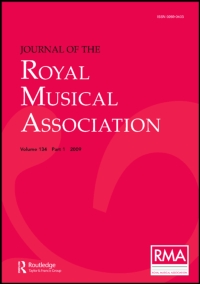Article contents
A Musicological Argument for Cultural Relationship Between Indonesia—Probably the Isle of Java—And Central Africa
Published online by Cambridge University Press: 01 January 2020
Extract
Your Association is so kind as to give me the opportunity to discuss some results obtained in the realm of musicology during recent years, and I will gladly use it to show you by a single example how much that branch of science is able to contribute to our knowledge of the history of civilisation.
- Type
- Research Article
- Information
- Copyright
- Copyright © Royal Musical Association, 1935
References
1 See Hornbostel, Musikalische Tonsysteme (in the Handbuch der Physik, ed. Geiger and Scheel, Vol. VIII, p. 435 et seq.). On p. 430 be says: “Actually, the difference is not exactly the same for all sizes and diameters of pipes: the longer the pipe, the diameter remaining constant, the smaller the blown fifth obtained. But for the usual average dimensions we may reckon, without great error, with a constant difference of 24 C.”Google Scholar
2 Hornbostel, “Ueber einige Panpfeifen aus Nordwest-Brasilien” (Th. Koch Grünberg, Zwei Jahre unter den Indianern, 1910); id. “Ueber ein akustisches Kriterium für Kulturzusammenhänge” (Zeitschrift für Ethnologie, 1911, p. 601 et seq.); id. A summary of the theory of blown fifths in Anthropos, Vol. XIV-XV, p. 569–570, 1919–20); id. “Die Maassnorm als kulturgeschichtliches Forschungsmittel” (Pater Wilhelm Schmidt-Festschrift, p. 303 et seq., 1928).Google Scholar
3 Jules Combarieu, Histoire de la Musique, Vol. I, p. 8.Google Scholar
4 Maurice Courant, Essai historique sur la musique classique del Chinois (Encyclopédie de la Musique, Lavignac, Vol. I, p. 80).Google Scholar
5 Hornbostel, Ueber ein akustisches Kriterium für Kulturzusammenhänge, p. 614.Google Scholar
6 Kunst, De toonkunst van Bali, Vol. I, p. 150, note.Google Scholar
7 Id. De musick in den Mangkoe Nagaran (Djåwå, Vol. IV, Mangkoe Nagarannumber, p. 28, 1924).Google Scholar
8 2 × 678 = 1,356 C.Google Scholar
1 × 1,200 = 1,200 C.Google Scholar
—————————
Difference: 156 C.Google Scholar
9 Of such a custom the fact that Burmese and West Javanese panpipes always are played in couples, is possibly a last remaining vestige. in the Javanese instruments the sex-difference also appears in their names: mother (indung) and son (anak).Google Scholar
10 Kunst, De Toonkunst van Java (1934), p. 22 et seq.Google Scholar
11 Moojen, P. A. J., Kunst op Bali (1926), plate XXIII; Dr. V. E. Korn, De dorpirepublick Tnganan Pagringzingan (1932), p. 18.Google Scholar
12 Curt Sachs, Die Musikinstruments Indiens und Indonesiens (1st ed: 1915), p. 34, fig. 20; Kunst-Goria, Hindoe-Javaansche muzickinstrumenten (1927), p. 102–3.Google Scholar
13 They only came to Central America later by way of the slave-trade.Google Scholar
14 Examples: Cat. of the Congo-Museum at Tervueren, Nos. 34538 (from the Balinda tribe in N.W. Belgian Congo); 34939 (from the Yakoma in South Belgian Congo). Still other materials are used for resonators, e.g., buffalo-horns (examples: British Museum Cat. CC 1910 No. 224; 1932 6–8 I (Yates collection)); and tins (see Percival R. Kirby, The Musical Instruments of the Native Races of South Africa (1934), plates 20B and 21A).Google Scholar
15 For a historical survey cf. Siegfried F. Nadel, Marimba-Musik Sitzungsberichte der Akademie der Wissenschaften in Wien, 212. Bands 1931), passim.Google Scholar
16 Von Hornbostel, Ueber ein akustisches Kriterium für Kulturzusammenhängs (Zeitschrift für Ethnologie, Vol. 43), 1911.Google Scholar
17 See the survey in Vol. II of the Encydopædie van Nederlandsch-Indiē 2nd ed., p. 817.Google Scholar
18 The degrees of the circle of blown fifths, calculated from O=366 vibr. upwards, are numbered with Roman ciphers.Google Scholar
19 Disregarding Central America; see note 13.Google Scholar
20 Kunst, De Toonkunst van Bali, Vol. I, p. 127, 335 (reprod. 39) and 236 (reprod. 40), and id. De Toonkunst van Java, Vol. I, p. 120–130.Google Scholar
21 Id. De Toonkunst van Java, Vol. I, p. 74–5; II, p. 341 (reprod. 47).Google Scholar
22 Id. ibid. Vol. II, p. 342 (reprod. 48).Google Scholar
23 Id. De Toonkunst van Bali, Vol. I, p. 237 (reprod. 41).Google Scholar
24 Junker, Reisen in Africa (1899), Vol. III, p. 15.Google Scholar
25 Kirby, The Musical Instruments of the Native Races of South Africa (1934), Table 16B.Google Scholar
26 Kunst, De Toonkunst van Bali, Vol. I, p. 75 and 136.Google Scholar
27 E.g., Congo Museum No. 24897 (Arandé).Google Scholar
28 These Guatemala instruments are also played by means of forked mallets: see Sachs, Geist und Werden der Musikinstrumente (1929), p. 128–9.Google Scholar
29 Cf. also: Hombostel, Musikalische Tonsysteme (in Geiger & Scheel, Handbuch act Physik, Vol. VIII, p. 435, ff), § 6.Google Scholar
30 This passage has not that meaning. Von Hombostel found out fry experiment that these twelfths were flat and therefore intended by this note to convey only that, as far as he knew, this phenomenon had not a scientific explanation, it had not even been observed. The Gesetzmässigkeit had not yet been studied, but the fact itself was for him beyond dispute.Google Scholar
31 The Dorian modal scale is also found on one of Hornbostel's Kubuflutes (No. 3295, SBd. f. vergleichende Ms. Wiss, 1, 1922), pp. 362 and 364; also on a peasant flute from Sicily, an Inca flute from Peru, a Carpathian flute and on one from N.W. India and others.Google Scholar
32 Examples of this Javanese notation may be found in Kunst, De Toonkunst van Java, Vol. II, p. 389 ff.Google Scholar
- 2
- Cited by


